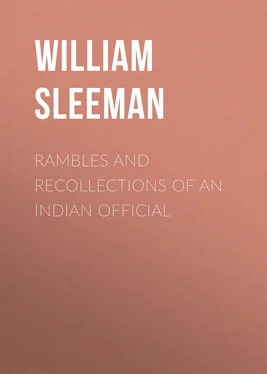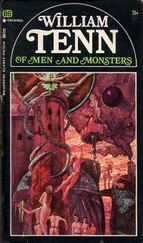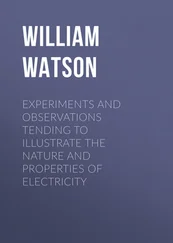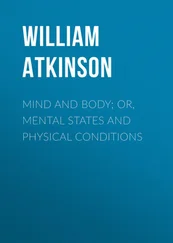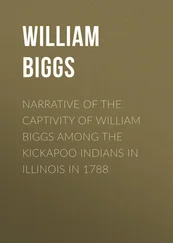William Sleeman - Rambles and Recollections of an Indian Official
Здесь есть возможность читать онлайн «William Sleeman - Rambles and Recollections of an Indian Official» — ознакомительный отрывок электронной книги совершенно бесплатно, а после прочтения отрывка купить полную версию. В некоторых случаях можно слушать аудио, скачать через торрент в формате fb2 и присутствует краткое содержание. Жанр: Путешествия и география, История, foreign_edu, foreign_antique, foreign_prose, на английском языке. Описание произведения, (предисловие) а так же отзывы посетителей доступны на портале библиотеки ЛибКат.
- Название:Rambles and Recollections of an Indian Official
- Автор:
- Жанр:
- Год:неизвестен
- ISBN:нет данных
- Рейтинг книги:4 / 5. Голосов: 1
-
Избранное:Добавить в избранное
- Отзывы:
-
Ваша оценка:
- 80
- 1
- 2
- 3
- 4
- 5
Rambles and Recollections of an Indian Official: краткое содержание, описание и аннотация
Предлагаем к чтению аннотацию, описание, краткое содержание или предисловие (зависит от того, что написал сам автор книги «Rambles and Recollections of an Indian Official»). Если вы не нашли необходимую информацию о книге — напишите в комментариях, мы постараемся отыскать её.
Rambles and Recollections of an Indian Official — читать онлайн ознакомительный отрывок
Ниже представлен текст книги, разбитый по страницам. Система сохранения места последней прочитанной страницы, позволяет с удобством читать онлайн бесплатно книгу «Rambles and Recollections of an Indian Official», без необходимости каждый раз заново искать на чём Вы остановились. Поставьте закладку, и сможете в любой момент перейти на страницу, на которой закончили чтение.
Интервал:
Закладка:
(4.) 1841.
History of Byza Bae (Baiza Bāī).
[Not to be published till after author's death. See unpublished letter dated Jhānsī, Oct. 22nd, 1841.]
(5.)
History of the Reigning Family of Oude.
[Intended to form a third volume of the Journey. See Author's Letter to Sir James Weir Hogg, Deputy Chairman, India House, dated Lucknow, 4th April, 1852; printed in Journey, vol. 2, p. 358.]
The manuscripts Nos. 1, 2, 4, and 5, and the printed papers Nos. 1, 3, 4, 10, 13, and 15, are in the possession of Captain J, L. Sleeman, Royal Sussex Regiment, grandson of the author. The India Office Library possesses copies of the printed works Nos. 2, 7, 8, 9, 11a, 12, 14 (vol. 1 only) and 16.
COMPARATIVE TABLE OF CHAPTERS
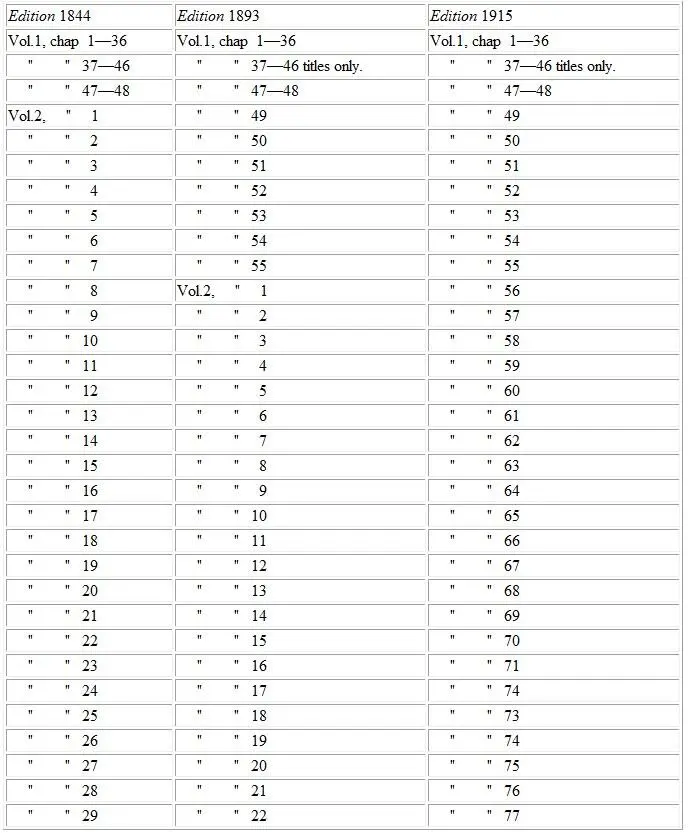
ABBREVIATIONS
A.C. After Christ.
Ann. Rep. Annual Report.
A.S. Archaeological Survey.
A.S.R. Archaeological Survey Reports, by Sir Alexander Cunningham and his assistants; 23 vols. 8vo, Simla and Calcutta, 1871-87, with General Index (vol. xxiv, 1887) by V. A. Smith.
A.S.W.I. Archaeological Survey Reports, Western India.
Beale. T. W. Beale, Oriental Biographical Dictionary, ed. Keene, 1894.
C.P. Central Provinces.
E.& D. Sir H. M. Elliot and Professor J. Dowson, The History of India as told by its own Historians, Muhammadan Period; 8 vols. 8vo, London, 1867-77.
E.H.I. V. A. Smith, Early History of India, 3rd ed., Oxford, 1914.
Ep. Ind. Epigraphia Indica, Calcutta.
Fanshawe. H. C. Fanshawe, Delhi Past and Present, Murray, London, 1902.
H.F.A. V. A. Smith, A History of Fine Art in India and Ceylon, 4to, Oxford, 1911.
I.G. Imperial Gazetteer of India , Oxford, 1907, 1908.
Ind. Ant. Indian Antiquary, Bombay.
J.A.S.B. Journal of the Asiatic Society of Bengal, Calcutta.
J.R.A.S. Journal of the Royal Asiatic Society, London.
N.I.N.& Qu. North-Indian Notes and Queries, Allahabad, 1891-6
N.W.P. North-Western Provinces.
Z.D.M.G. Zeitschrift der deutschen morgenländischen Gesellschaft, Leipzig.
RAMBLES AND RECOLLECTIONS
CHAPTER 1
Before setting out on our journey towards the Himālaya we formed once more an agreeable party to visit the Marble Rocks of the Nerbudda at Bherāghāt. 8 8 The Nerbudda (Narbadā, or Narmadā) river is the boundary between Hindustan, or Northern India, and the Deccan (Dakhin), or Southern India. The beautiful gorge of the Marble Rocks, near Jubbulpore (Jabalpur), is familiar to modern tourists (see I.G. , 1908, s.v. 'Marble Rocks'). The remarkable antiquities at Bherāghāt are described and illustrated in A.S.R. , vol. ix, pp. 60-76, pl. xii-xvi. Additions and corrections to Cunningham's account will be found in A.S.W.I Progr. Rep. , 1893-4, p. 5; and A.S. Ann. Rep., E. Circle , 1907-8, pp. 14-18.
It was the end of Kārtik, 9 9 The eighth month of the Hindoo luni-solar year, corresponding to part of October and part of November. In Northern India the year begins with the month Chait, in March. The most commonly used names of the months are: (1) Chait; (2) Baisākh; (3) Jēth; (4) Asārh; (5) Sāwan; (6) Bhādon; (7) Kuār; (8) Kārtik; (9) Aghan; (10) Pūs; (II) Māgh; and (12) Phālgun.
when the Hindoos hold fairs on all their sacred streams at places consecrated by poetry or tradition as the scene of some divine work or manifestation. These fairs are at once festive and holy; every person who comes enjoying himself as much as he can, and at the same time seeking purification from all past transgressions by bathing and praying in the holy stream, and making laudable resolutions to be better for the future. The ceremonies last five days, and take place at the same time upon all the sacred rivers throughout India; and the greater part of the whole Hindoo population, from the summits of the Himālaya mountains to Cape Comōrin, will, I believe, during these five days, be found congregated at these fairs. In sailing down the Ganges one may pass in the course of a day half a dozen such fairs, each with a multitude equal to the population of a large city, and rendered beautifully picturesque by the magnificence and variety of the tent equipages of the great and wealthy. The preserver of the universe ( Bhagvān ) Vishnu is supposed, on the 26th of Asārh, to descend to the world below ( Pātāl ) to defend Rājā Bali from the attacks of Indra, to stay with him four months, and to come up again on the 26th Kārtik. 10 10 Bhagvān is often used as equivalent for the word God in its most general sense, but is specially applicable to the Deity as manifested in Vishnu the Preserver. Asārh corresponds to June-July, Pātāl is the Hindoo Hades. Rājā Bali is a demon, and Indra is the lord of the heavens. The fairs take place at the time of full moon.
During his absence almost all kinds of worship and festivities are suspended; and they recommence at these fairs, where people assemble to hail his resurrection.
Our tents were pitched upon a green sward on one bank of a small stream running into the Nerbudda close by, while the multitude occupied the other bank. At night all the tents and booths are illuminated, and the scene is hardly less animated by night than by day; but what strikes a European most is the entire absence of all tumult and disorder at such places. He not only sees no disturbance, but feels assured that there will be none; and leaves his wife and children in the midst of a crowd of a hundred thousand persons all strangers to them, and all speaking a language and following a religion different from theirs, while he goes off the whole day, hunting and shooting in the distant jungles, without the slightest feeling of apprehension for their safety or comfort. It is a singular fact, which I know to be true, that during the great mutiny of our native troops at Barrackpore in 1824, the chief leaders bound themselves by a solemn oath not to suffer any European lady or child to be injured or molested, happen what might to them in the collision with their officers and the Government. My friend Captain Reid, one of the general staff, used to allow his children, five in number, to go into the lines and play with the soldiers of the mutinous regiments up to the very day when the artillery opened upon them; and, of above thirty European ladies then at the station, not one thought of leaving the place till they heard the guns. 11 11 Barrackpore, fifteen miles north of Calcutta, is still a cantonment. The Governor General has a country house there. The mutiny of the native troops stationed there occurred on Nov. 1, 1824, and was due to the discontent caused by orders moving the 47th Native Infantry to Rangoon to take part in the Burmese War. The outbreak was promptly suppressed. Captain Pogson published a Memoir of the Mutiny at Barrackpore (8vo, Serampore, 1833).
Mrs. Colonel Faithful, with her daughter and another young lady, who had both just arrived from England, went lately all the way from Calcutta to Lūdiāna on the banks of the Hyphasis, a distance of more than twelve hundred miles, in their palankeens with relays of bearers, and without even a servant to attend them. 12 12 Lūdiāna, the capital of the district of the same name, now under the Punjab Government. Hyphasis is the Greek name of the Biās river, one of the five rivers of the Punjāb.
They were travelling night and day for fourteen days without the slightest apprehension of injury or of insult. Cases of ladies travelling in the same manner by dāk (stages) immediately after their arrival from England to all parts of the country occur every day, and I know of no instance of injury or insult sustained by them. 13 13 Railways have rendered almost obsolete the mode of travelling described in the text. In Northern India palankeens (pālkīs) are now seldom used, even by Indians, except for purposes of ceremony.
Does not this speak volumes for the character of our rule in India? Would men trust their wives and daughters in this manner unprotected among a people that disliked them and their rule? We have not a garrison, or walled cantonments, or fortified position of any kind for our residence from one end of our Eastern empire to the other, save at the three capitals of Calcutta, Madras, and Bombay. 14 14 This statement is no longer quite accurate, though fortified positions are still very few.
We know and feel that the people everywhere look up to and respect us, in spite of all our faults, and we like to let them know and feel that we have confidence in them.
Интервал:
Закладка:
Похожие книги на «Rambles and Recollections of an Indian Official»
Представляем Вашему вниманию похожие книги на «Rambles and Recollections of an Indian Official» списком для выбора. Мы отобрали схожую по названию и смыслу литературу в надежде предоставить читателям больше вариантов отыскать новые, интересные, ещё непрочитанные произведения.
Обсуждение, отзывы о книге «Rambles and Recollections of an Indian Official» и просто собственные мнения читателей. Оставьте ваши комментарии, напишите, что Вы думаете о произведении, его смысле или главных героях. Укажите что конкретно понравилось, а что нет, и почему Вы так считаете.
